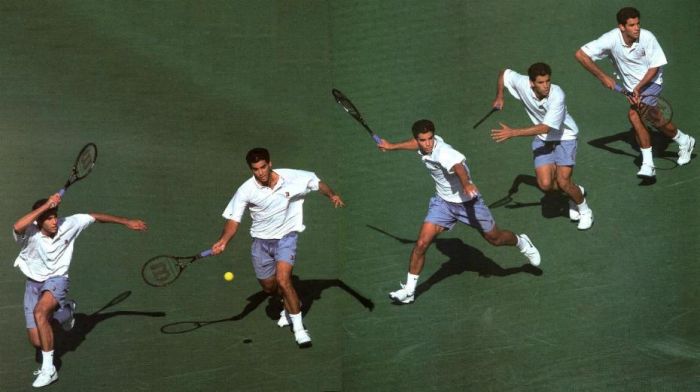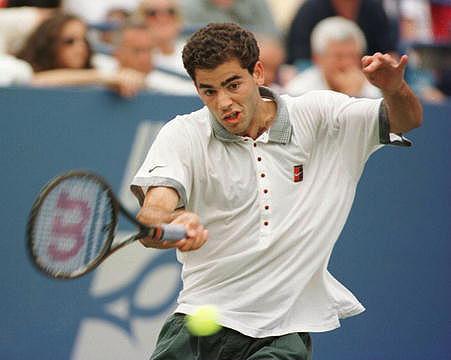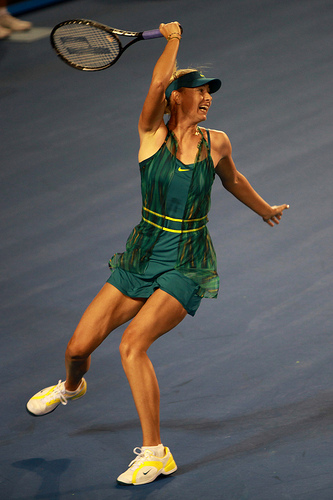We all have a mental picture of Nadal, Sharapova or Roger Federer using a reverse forehand during a tennis match. The reverse forehand in tennis has also been termed the “buggy whip” forehand because the follow through of the racket and arm is different than a normal forehand follow through.
In today’s game, it’s important to recognize the reverse forehand and learn when to use this shot effectively even at the club level.
Learning the Reverse Forehand
In the 1990’s, Pete Sampras burst onto the tennis scene with his sizzling serve, super forehand and nonpareil athleticism. The Sampras serve has gone on to become perhaps the single most devastating shot in the history of the game. However, there was another shot that he hit with unusual aplomb that garnered plenty of attention: his running forehand.
Sampras basically modelled his forehand technique from Ivan Lendl, who was comfortable running around his backhand to hit big inside out forehands. Sampras had the ability to do the same but there was a disadvantage to this tactic. It left too much open court. Lendl could get away with this because he was so overpowering. Sampras had a lot of power on his forehand as well, but his rivals had also learned to hit very hard as well.


Learning from Pete Sampras’s Reverse Forehand
His main rival, Andre Agassi, was highly adept at hitting down the line backhands, which exposed his forehand corner. Another rival, Goran Ivanisevic, was left handed so he could also exploit this opening. Fortunately for Pete, he was blessed with unbelievable speed and he could run down these hard shots wide to his forehand. Still, the balls were flying by so fast that he had to modify his technique a little.


Sampras used an eastern forehand grip which enabled him to stretch out his arm and still have his wrist in a strong position relative to the handle of the racket. Dead on the run, with not a lot of time to waste, Sampras took his racket back then swung at the ball with a fully outstretched arm. The racket face hit the ball squarely from behind. But his momentum continued to take him to the right, and not forward into the ball.
Through instinct, he reversed his finish. Instead of following through forward and across his body, he whipped the racket over his head and finished over his right shoulder instead of his left. This steep and very quick upward flick of the racket imparted tremendous topspin on the ball, making it curve back into the court. He was also able to time this shot very well and use the pace of the incoming ball to produce his own pace. The result was a very accurate and deadly shot.


Later in his career, with more and more power players crowding the men’s tour, Sampras began using the reverse forehand with greater frequency. He also began using it not just for his running shot but also for some approach shots and angled shots.
Lindsay Davenport: Another example of the Reverse Forehand Follow through
Meanwhile, on the women’s tour, Sampras’ fellow Californian Lindsay Davenport was bringing a new level of power hitting. Like Pete, her strokes were smooth and powerful but unlike Pete, she was not a great athlete.
When she was forced to run for a ball, she was at the mercy of her opponent. While she worked hard to improve her speed, she also began adapting the reverse forehand technique on wide balls to her right side. She also used the eastern grip and had a similar technique to hit this type of shot and she smartly chose to go deep cross court most of the time. It enabled her to stay in the point and even turn it around in her favour.
Sharapova’s Stint with the Reverse Forehand Shot
At the 2004 Wimbledon semi-finals, Davenport came up against a 17 year old upstart with a powerful baseline game not unlike her own. Her name was Maria Sharapova. She went on to beat Davenport and, later in the final, Serena Williams to claim her first major title. Sharapova’s main difference from Lindsay, apart from her shrieking and her age, was that she held the racket with a western grip on her forehand. Because the grass made the ball skid and bounce fast and low.
Sharapova was frequently caught in seemingly awkward positions on the forehand side. Maria compensated by preparing quickly, hitting from an open stance and swinging steeply upward at the ball. Her racket head speed was so fast and the hit very well-timed that she produced great power, spin, depth or angle. Because of her steep upward swing, her follow through took the racket above her head and over her right shoulder. Sharapova had become another proponent of the reverse forehand.


However, she was also not blessed with great athletic ability. On some forehands, she looked like she was hitting off balance because of the way she transferred her weight from her open stance. She shifted her weight from her right foot (which was her back foot) to her left foot but seemed to tilt her torso to her left on the finish.
This partial loss of perfect balance made it difficult to recover for the next shot. But since she was so aggressive and dictating many of the points, she could cover up this weakness. In the ensuing years, players began to solve her style so she had to adapt and change her technique on her forehand.
She now uses the more conventional style of finishing over the left shoulder. Her stance isn’t quite as open as before so she is able to maintain her balance throughout the stroke while putting all of her weight into the shot.
Still, Maria Sharapova reverts to using a lot of reverse forehands especially when she is playing an equally powerful and aggressive player who can cut down her time. In her last two grand slam events, Li Na and Petra Kvitova forced her off balance by blasting their returns deep and fast to her forehand.
Roger Federer and Rafael Nadal’s Use of the Reverse Forehand Follow through
As the men’s game evolved and players began using more of a baseline oriented game dominated by topspin shots, the forehand featuring the windshield-wiper finish became more and more common. Roger Federer was at the forefront of tennis throughout the 2000’s and he uses this technique.
Like his predecessor Sampras, Roger had unbelievable athletic ability. He is also one of the most versatile players ever. His adaptability to hit any kind of shot in any situation is a vital reason as to why he has been able to build what is widely considered the most impressive resume of any tennis player in history.
On wide and fast balls to his forehand, he also uses the reverse forehand. He sprints over and takes the same kind of looped backswing as on his regular forehand. With the racket held in a grip that is between eastern and semi-western, he hits the ball out in front, straightening his arm at contact, and keeping the wrist cocked back.
Federer hits through the ball and extends out forward to the target before sweeping the racket steeply upward over his head and finishing over his right shoulder. Alternatively, he will hit this shot from a relatively stationary position on his forehand corner to create a very acute angle. Another shot he can hit with this technique is the topspin lob.
Nadal’s Heavy Topspin Approach With the Reverse Forehand
Federer’s main rival Rafael Nadal has come to epitomize the topspin baseline oriented game even more. His grip is full western and the amount of spin he puts on the ball from his forehand results in a shot with unprecedented weight. Nadal was second to Federer through most of the mid 2000’s before finally taking over in 2008. He has been able to beat Roger in many occasions because his left handed forehand plays to Federer’s backhand which is less adept at handling high, heavy balls.
Windshield Wiper Follow Through Vs. the Reverse Forehand Follow through
Nadal can use either the windshield wiper follow through or the reverse forehand follow through to create extra topspin to produce higher and heavier balls. He hits from an open stance and takes the racket back in a looped backswing just as he normally would. He brings the racket head below the level of the ball and unleashes his forward swing by hitting the ball out in front.
Like Federer, he straightens out his arm at contact but keeps his wrist laid back. He shifts his weight from back foot (left foot) to front foot. He then sweeps the racket steeply upward over his head in a lassoing motion before finishing over his left shoulder. He has great strength, especially in his hitting arm so the racket head speed he can produce is totally out of this world.
Because the pros are so often copied, junior players and even club players are using reverse forehands as well. This works because it allows them to catch up to the ball when it is coming too fast for them to hit their regular forehands. However, the shot they produce isn’t the same because they can’t whip the racket head as fast for power and topspin. So if you want to hit the reverse forehand the same way as the pros do, you have to get stronger and fitter first.
Learn to Hit a Forehand Like Roger Federer
If you want to jumpstart your forehand and play like the PROS, check out my 70+ page Tennis Ebook that will immediately show you how you can take your forehand to the next level.
The Modern Forehand Domination Ebook is guaranteed to improve your tennis technique, and increase power, topspin and accuracy of your tennis forehand!
Modern Tennis Forehand Ebook
Learn How to Hit a Forehand Like Federer, Nadal and Djokovic

